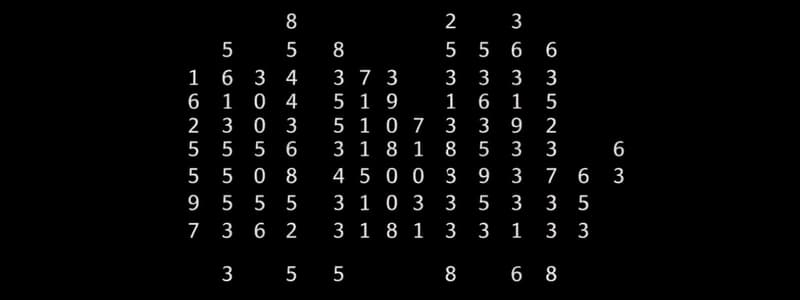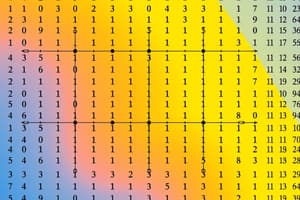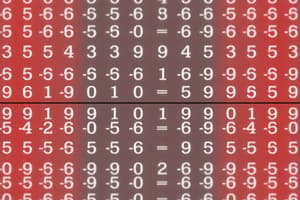Podcast
Questions and Answers
According to Catholic belief, what transformation occurs during the Eucharist?
According to Catholic belief, what transformation occurs during the Eucharist?
- The bread and wine are blessed but remain unchanged.
- The bread and wine become symbols representing Jesus' body and blood.
- The bread and wine are completely changed into the body and blood of Jesus. (correct)
- The bread and wine are partially changed into spiritual nourishment.
What is the term used to describe the changing of the bread and wine into the body and blood of Jesus?
What is the term used to describe the changing of the bread and wine into the body and blood of Jesus?
- Transcendence
- Transubstantiation (correct)
- Translation
- Transformation
Besides the Eucharist, what is the Eucharist also called?
Besides the Eucharist, what is the Eucharist also called?
- The Holy Offering
- The Blessed Sacrament (correct)
- The Divine Blessing
- The Sacred Meal
Where are the remaining consecrated hosts kept after Mass?
Where are the remaining consecrated hosts kept after Mass?
From where can Holy Communion be taken to the sick?
From where can Holy Communion be taken to the sick?
Before receiving Holy Communion, what is the fasting requirement?
Before receiving Holy Communion, what is the fasting requirement?
What should be avoided during the fasting period before receiving Communion?
What should be avoided during the fasting period before receiving Communion?
According to the scripture link provided, what miracle foreshadows that of the Eucharist?
According to the scripture link provided, what miracle foreshadows that of the Eucharist?
During the Mass, what are the two main parts?
During the Mass, what are the two main parts?
What does the term Eucharist mean?
What does the term Eucharist mean?
What is offered on an altar?
What is offered on an altar?
What is the altar server wearing around their shoulders?
What is the altar server wearing around their shoulders?
What is the chalice used for?
What is the chalice used for?
What does the priest say when offering the Eucharist and how should the people respond?
What does the priest say when offering the Eucharist and how should the people respond?
What are the two options of how to receive the Host during Communion?
What are the two options of how to receive the Host during Communion?
What gesture is expected of Catholics when receiving the Precious Blood?
What gesture is expected of Catholics when receiving the Precious Blood?
What does the Priest wear?
What does the Priest wear?
What are the two main parts of Mass?
What are the two main parts of Mass?
From what language does the word Mass originate?
From what language does the word Mass originate?
According to Catholic tradition, at the end of Mass where are we sent?
According to Catholic tradition, at the end of Mass where are we sent?
Flashcards
Eucharist Synonym
Eucharist Synonym
The Eucharist is also called the Blessed Sacrament.
Tabernacle
Tabernacle
A special place of honor where consecrated hosts are kept after Mass.
Jesus as Food
Jesus as Food
Amazing! Jesus becomes food for us in the bread and wine.
Altar
Altar
Signup and view all the flashcards
Vestments
Vestments
Signup and view all the flashcards
Alb
Alb
Signup and view all the flashcards
Stole
Stole
Signup and view all the flashcards
Chasuble
Chasuble
Signup and view all the flashcards
Ciborium
Ciborium
Signup and view all the flashcards
Chalice
Chalice
Signup and view all the flashcards
Eucharist Meaning
Eucharist Meaning
Signup and view all the flashcards
Bread and Wine
Bread and Wine
Signup and view all the flashcards
Communion Fast
Communion Fast
Signup and view all the flashcards
Reverence
Reverence
Signup and view all the flashcards
Meaning of 'Amen'
Meaning of 'Amen'
Signup and view all the flashcards
Two Main Parts of Mass
Two Main Parts of Mass
Signup and view all the flashcards
St. Pius X
St. Pius X
Signup and view all the flashcards
Origin of the Word Mass
Origin of the Word Mass
Signup and view all the flashcards
Transubstantiation
Transubstantiation
Signup and view all the flashcards
Institution of Eucharist
Institution of Eucharist
Signup and view all the flashcards
Study Notes
Matrices
- A matrix is a rectangular array of numbers, symbols, or expressions arranged in rows and columns.
Special Matrices
Zero Matrix
- All elements are zero.
- Example: $\begin{bmatrix}0 & 0 \ 0 & 0\end{bmatrix}$
Identity Matrix
- A square matrix with 1s on the diagonal and 0s elsewhere.
- Example: $\begin{bmatrix}1 & 0 \ 0 & 1\end{bmatrix}$
Diagonal Matrix
- A square matrix with non-diagonal elements as zero.
- Example: $\begin{bmatrix}a & 0 \ 0 & d\end{bmatrix}$
Transpose Matrix
- Denoted as $A^T$, it is formed by interchanging the rows and columns of matrix A.
- If $A = \begin{bmatrix}a & b \ c & d \ e & f\end{bmatrix}$, then $A^T = \begin{bmatrix}a & c & e\ b & d & f\end{bmatrix}$
Symmetric Matrix
- A square matrix that is equal to its transpose ($A = A^T$).
- Example: $A = \begin{bmatrix}a & b \ b & d\end{bmatrix}$
Skew-Symmetric Matrix
- A square matrix where its transpose equals its negative ($A^T = -A$).
- Diagonal elements are always zero.
- Example: $A = \begin{bmatrix}0 & b \ -b & 0\end{bmatrix}$
Triangular Matrix
Upper Triangular Matrix
- All elements below the main diagonal are zero.
- Example: $\begin{bmatrix}a & b \ 0 & d\end{bmatrix}$
Lower Triangular Matrix
- All elements above the main diagonal are zero.
- Example: $\begin{bmatrix}a & 0 \ c & d\end{bmatrix}$
Matrix Operations
Addition
- Add corresponding elements, $A + B = [a_{ij} + b_{ij}]$.
- Example: $\begin{bmatrix}a & b \ c & d\end{bmatrix} + \begin{bmatrix}e & f \ g & h\end{bmatrix} = \begin{bmatrix}a+e & b+f \ c+g & d+h\end{bmatrix}$
Subtraction
- Subtract corresponding elements, $A - B = [a_{ij} - b_{ij}]$.
- Example: $\begin{bmatrix}a & b \ c & d\end{bmatrix} - \begin{bmatrix}e & f \ g & h\end{bmatrix} = \begin{bmatrix}a-e & b-f \ c-g & d-h\end{bmatrix}$
Scalar Multiplication
- Multiply each element by the scalar, $cA = [ca_{ij}]$.
- Example: $c\begin{bmatrix}a & b \ c & d\end{bmatrix} = \begin{bmatrix}ca & cb \ cc & cd\end{bmatrix}$
Matrix Multiplication
- For an $m \times n$ matrix A and an $n \times p$ matrix B, the product AB is an $m \times p$ matrix.
- $(AB){ij} = \sum{k=1}^{n} a_{ik}b_{kj}$
- Example: $\begin{bmatrix}a & b \ c & d\end{bmatrix} \begin{bmatrix}e & f \ g & h\end{bmatrix} = \begin{bmatrix}ae+bg & af+bh \ ce+dg & cf+dh\end{bmatrix}$
Algorithmes de Hachage
Définition
- Un algorithme de hachage est une fonction qui prend une entrée de taille arbitraire et produit une sortie de taille fixe, appelée haché.
Propriétés
- Déterministe: La même entrée produit toujours le même haché.
- Calcul rapide: Le calcul du haché doit être rapide.
- Résistance à la préimage: Il doit être difficile de trouver une entrée qui produit un haché donné.
- Résistance à la seconde préimage: Il doit être difficile de trouver une deuxième entrée différente qui produit le même haché qu'une entrée donnée.
- Résistance aux collisions: Il doit être difficile de trouver deux entrées différentes qui produisent le même haché.
- Fonction à sens unique: Facile à calculer dans un sens, difficile à inverser.
- Effet d'avalanche: Une petite modification de l'entrée doit entraîner une modification importante du haché.
Applications
- Vérification de l'intégrité des données: Comparer les hachés de deux versions d'un fichier pour détecter les modifications.
- Stockage de mots de passe: Stocker les hachés des mots de passe plutôt que les mots de passe eux-mêmes pour des raisons de sécurité.
- Tables de hachage: Utiliser les hachés comme indices pour stocker et récupérer des données dans une table de hachage.
- Signatures numériques: Hacher un document avant de le signer numériquement pour des raisons d'efficacité.
- Blockchain: Utiliser les hachés pour lier les blocs dans une blockchain et assurer l'intégrité de la chaîne.
Exemples d'algorithmes de hachage
- MD5: Produit un haché de 128 bits (obsolète en raison de faiblesses de sécurité).
- SHA-1: Produit un haché de 160 bits (obsolète en raison de faiblesses de sécurité).
- SHA-256: Produit un haché de 256 bits (largement utilisé).
- SHA-384: Produit un haché de 384 bits.
- SHA-512: Produit un haché de 512 bits.
- SHA-3: Une famille d'algorithmes de hachage développée par le NIST pour remplacer SHA-2.
- bcrypt: Un algorithme de hachage de mots de passe basé sur Blowfish.
- scrypt: Un algorithme de hachage de mots de passe qui nécessite une grande quantité de mémoire.
- Argon2: Un algorithme de hachage de mots de passe qui a remporté le Password Hashing Competition.
Attaques Courantes
- Attaque par force brute: Essayer toutes les entrées possibles jusqu'à ce qu'une entrée qui produit le haché cible soit trouvée.
- Attaque par dictionnaire: Essayer les entrées d'un dictionnaire de mots courants et de phrases jusqu'à ce qu'une entrée qui produit le haché cible soit trouvée.
- Attaque arc-en-ciel: Utiliser une table précalculée de hachés pour trouver une entrée qui produit le haché cible.
- Attaque de collision: Trouver deux entrées différentes qui produisent le même haché.
- Attaque de longueur d'extension: Exploiter la structure interne de certains algorithmes de hachage pour calculer le haché d'une entrée plus longue sans connaître l'entrée d'origine.
Sélection d'un Algorithme de Hachage
- Sécurité: Choisir un algorithme qui est résistant aux attaques connues.
- Performance: Choisir un algorithme qui est suffisamment rapide pour l'application.
- Taille du haché: Choisir une taille de haché qui est suffisamment grande pour éviter les collisions.
- Disponibilité: Choisir un algorithme qui est largement disponible et pris en charge.
- Standard: Choisir un algorithme standardisé pour assurer l'interopérabilité.
Conclusion
- Les algorithmes de hachage sont un outil essentiel pour de nombreuses applications de sécurité.
- Il est important de comprendre leurs propriétés, leurs applications et leurs limites afin de les utiliser efficacement.
Factorial ANOVA
Basic Concepts
Factorial Design
- Two or more IVs are manipulated to investigate interaction effects.
Example
- Consider the effect of exercise and/or diet on weight loss.
- Two IVs: exercise and diet.
- Exercise: yes or no.
- Diet: yes or no.
- Four groups are formed: Exercise and diet, Exercise and no diet, No exercise and diet, and No exercise and no diet.
Main Effect
- Effect of one IV on the DV, ignoring the other IV(s).
Interaction Effect
- Effect of one IV on the DV depends on the level of the other IV(s).
Two-way ANOVA
Hypotheses
- Main effect of exercise: $H_0: \mu_{exercise} = \mu_{no\ exercise}$.
- Main effect of diet: $H_0: \mu_{diet} = \mu_{no\ diet}$.
- Interaction effect: The effect of exercise on weight loss depends on diet.
ANOVA Table
- Summary of the ANOVA results, showing sources of variation, degrees of freedom (df), sum of squares (SS), mean squares (MS), and F-ratios (F) | Source | df | SS | MS | F | | --------------- | ----------- | ----------- | ----------- | ----------- | | Exercise | $df_{ex}$ | $SS_{ex}$ | $MS_{ex}$ | $F_{ex}$ | | Diet | $df_{di}$ | $SS_{di}$ | $MS_{di}$ | $F_{di}$ | | Exercise x Diet | $df_{exdi}$ | $SS_{exdi}$ | $MS_{exdi}$ | $F_{exdi}$ | | Error | $df_e$ | $SS_e$ | $MS_e$ | | | Total | $df_t$ | $SS_t$ | | |
Degrees of Freedom
- $df_{ex} = a - 1$ (a = number of levels of exercise).
- $df_{di} = b - 1$ (b = number of levels of diet).
- $df_{ex*di} = (a - 1)(b - 1)$.
- $df_e = N - ab$ (N = total participants).
- $df_t = N - 1$.
Sum of Squares
- $SS_{ex} = n \cdot b \cdot \sum_{i=1}^{a} (\bar{x}{i.} - \bar{x}{..})^2$.
- $SS_{di} = n \cdot a \cdot \sum_{j=1}^{b} (\bar{x}{.j} - \bar{x}{..})^2$.
- $SS_{ex*di} = n \cdot \sum_{i=1}^{a} \sum_{j=1}^{b} (\bar{x}{ij} - \bar{x}{i.} - \bar{x}{.j} + \bar{x}{..})^2$.
- $SS_t = \sum_{i=1}^{a} \sum_{j=1}^{b} \sum_{k=1}^{n} (x_{ijk} - \bar{x}_{..})^2$.
- $SS_e = SS_t - SS_{ex} - SS_{di} - SS_{ex*di}$.
Mean Squares
- $MS_{ex} = \frac{SS_{ex}}{df_{ex}}$.
- $MS_{di} = \frac{SS_{di}}{df_{di}}$.
- $MS_{exdi} = \frac{SS_{exdi}}{df_{ex*di}}$.
- $MS_e = \frac{SS_e}{df_e}$.
F-Ratios
- $F_{ex} = \frac{MS_{ex}}{MS_e}$.
- $F_{di} = \frac{MS_{di}}{MS_e}$.
- $F_{exdi} = \frac{MS_{exdi}}{MS_e}$.
Example Setup
- Consider an example with N = 20, n = 5, and data organized in a table with means for each condition.
| Diet | No diet | ||
|---|---|---|---|
| Exercise | 8 | 4 | $\mu$ = 6 |
| No exercise | 2 | 6 | $\mu$ = 4 |
| $\mu$ = 5 | $\mu$ = 5 |
Null Hypotheses
- $H_0$: No main effect of exercise: $(6 - 5) = (4 - 5) = 0$.
- $H_0$: No main effect of diet: $(5 - 5) = (5 - 5) = 0$.
- $H_0$: No interaction effect: $(8 - 4) = (2 - 6) = 0$.
ANOVA Table Example
| Source | df | SS | MS | F |
|---|---|---|---|---|
| Exercise | 1 | 20 | 20 | 5 |
| Diet | 1 | 0 | 0 | 0 |
| Exercise x Diet | 1 | 60 | 60 | 15 |
| Error | 16 | 64 | 4 | |
| Total | 19 | 144 |
Calculation of Sum of Squares (SS)
- Using the provided forumlas and values we can calculate the following:
$SS_{exercise} = n \cdot b \cdot \sum_{i=1}^{a} (\bar{x}{i.} - \bar{x}{..})^2 = 5 \cdot 2 \cdot [(6 - 5)^2 + (4 - 5)^2] = 20$.
$SS_{diet} = n \cdot a \cdot \sum_{j=1}^{b} (\bar{x}{.j} - \bar{x}{..})^2 = 5 \cdot 2 \cdot [(5 - 5)^2 + (5 - 5)^2] = 0$.
$SS_{exercise*diet} = n \cdot \sum_{i=1}^{a} \sum_{j=1}^{b} (\bar{x}{ij} - \bar{x}{i.} - \bar{x}{.j} + \bar{x}{..})^2 = 5 \cdot [(8 - 6 - 5 + 5)^2 + (4 - 6 - 5 + 5)^2 + (2 - 4 - 5 + 5)^2 + (6 - 4 - 5 + 5)^2] = 60$.
$SS_e = SS_t - SS_{ex} - SS_{di} - SS_{ex*di} = 144 - 20 - 0 - 60 = 64$.
Interpretation
- Main effect of exercise: $F(1, 16) = 5, p
Studying That Suits You
Use AI to generate personalized quizzes and flashcards to suit your learning preferences.




